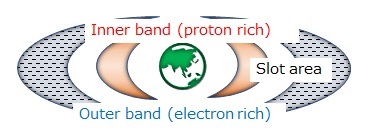4.2 Formation of Van Allen Belt and weather circulation around the Earth by Solar Wind
[Formation of Van Allen radiation belt]
The Earth has a magnetosphere that extends to areas where there is no atmosphere.
The solar wind first interacts with the magnetosphere. When the solar wind
enters the Earth's magnetosphere, some electrons and H+ of the Sun's plasma
behave differently depending on the Lorentz force of the Earth's geomagnetic
field. The Van Allen radiation zone has a “slot area” with no charged particles
between 6,000 km and 13,000 km, with an outer band of altitudes of 10,000
to 20,000 km and an inner band of 2,000 to 5,000 km.
Because of the small mass of electrons, some electrons in the solar wind
are first caught in the magnetic field line to form the outer belt of the
Van Allen belt. As a result, the decrease in electron density results in
an increase in positive charge. The mass of H+ is 1836 times that of electrons, and H+ forms an inner band captured by a strong magnetic field line inside because it has a velocity of several hundreds km/sec.
There is the slot region where charged particles do not exist between
the outer and inner zone as shown in Fig.7. Since electrons and protons
rotate opposite direction along the magnetic field lines, the recombination
decreases the charged particles.

Fig.10 Structure of the Van Allen band.
[ Weather circulation around the Earth by solar wind]
Since the Earth has a magnetosphere, the effect of solar wind on the air flow of the atmosphere is not as strong as Venus.
The ionosphere possesses with a high electron density, and it reflects radio waves. But H+ with high speed does not reflect the radio waves directly.
The high-speed H+ enters the atmosphere without coupling with electrons, and the solar wind H+ collides with the molecules of upper atmosphere and loses its speed.
The H+ of solar wind collides with atoms and molecules in the upper atmosphere to form an ionization layer by the emitted electrons.
The density of hydrogen atoms peaks around altitude 90km, and there is a peak ozone layer around altitude 25km, the H+ of the solar wind rarely reaches the ground unless strike of huge magnetic storm.
However, H+ drives flow of the atmosphere by collisions with molecules and atoms in
the atmosphere.
S. Karasawa pointed out that the solar wind drives the air flow of upper
atmosphere. The atmosphere is also moving with the Earth's rotation, and
the speed near the equator is about the speed of a jet airliner. Therefore,
solar winds that passes through the sides of Earth accelerate on the east side
and slow down on the west side, so Earth's weather is turned counterclockwise.
Since the solar wind has rotational properties due to the Sun's rotation,
it drives the trade wind in the direction of clock rotation around the
equator of the Earth's daytime hemisphere.
As shown in Fig.11, the westerly winds and trade winds orbiting the Earth
are driven by the Earth's rotation and the solar wind H+,

Fig.11 Weather circulation around the Earth by the solar wind
index -4.2-